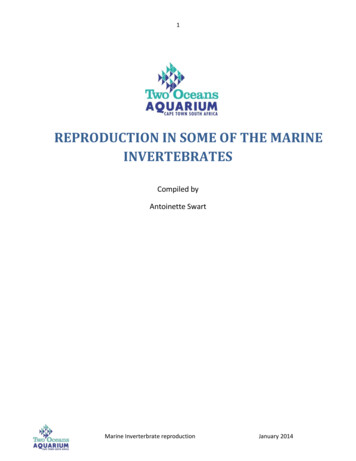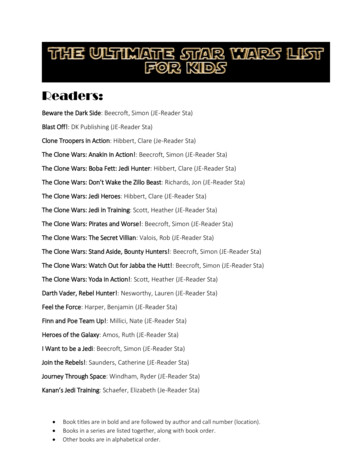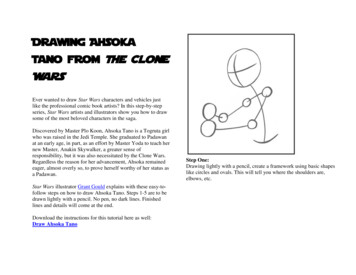
Transcription
SPERMWARSInfidelity, Sexual Conflict and OtherBedroom BattlesRobin BakerFOURTH ESTATE London
First published in Great Britain in 1996 byFourth Estate Limited6 Salem RoadLondon, W2 4BUToKECopyright 1996 by Robin BakerJThe right of Robin Baker to be identified as the author of this workhas been asserted by him in accordance with the Copyright,Designs and Patents Act 1988.A catalogue record for this book is availablefrom the British Library.ISBN 1-85702-356-0All rights reserved. No part of this publication may be reproduced,transmitted, or stored in a retrieval system, in any form or by anymeans. without permission in writing from Fourth Estate Limited.Typeset by Palimpsest Book Production Limited,Polmont, StirlingshirePrinted in Great Britain byCox & Wyman Ltd, Reading, Berks.F,YA,J,K,P,P,R,S, 'W'andThomas, Howard, David, Nathanial, Ameliaand the baby who was never named
ContentsPreface1The Generation Game121Normal ServiceThe Wet SheetTopping UpConception5152632Sperm Wars674Great Uncle Who?Routine Sex23453xiA Chance AffairA Sperm War3648Counting the Cost891011Doesn't He Look like His Father?Making MistakesLicking InfidelityCheckmatevii55616976
PrefaceSex and reproduction occupy a major part of people's time -notso much the doing, more the thinking and talking. Despite all ofthis attention, most people find their own sexual activities,responses and emotions the most baffling of all aspects of theirlives. Consider the following.Why, in the midst of a perfectly happy and satisfying relationship, do we sometimes get an incredibly strong urge to beunfaithful? Why do men inseminate enough sperm at eachintercourse to fertilise the entire population of the United States- twice over? And why, then, do half of them dribble back downthe woman's leg? Why should we feel like sex so often whenmost of the time we don't want children? Why, when we leastwant children, do our bodies apparently let us down andproduce them? Why, when we do want children, do our bodiesapparently let us down and not produce them? Why is it sodifficult to know the best time to have sex in order to conceive or not to conceive? Why is the penis the shape it is and why dowe thrust during intercourse? Why do we get such strong urgesto masturbate, and why do some of us have orgasms whileasleep at night? Why is the female orgasm so unpredictableand so difficult to induce? Why are some people moreinterested in sex with members of their own sex?These are just some of the questions to which most people, ifthey are honest, have no sensible or at least consistent answer.None the less, riding on the wave of a revolution in sexualunderstanding which began in the 1970s but which did notxi
PREFACEreally gather momentum until the 1990s, these are questionswhich this book sets out to answer.So far, this revolution in the interpretation of sexual behaviourhas been the sole prerogative of academics — evolutionarybiologists, to be precise. In this book, my aim is to bring the newinterpretation for the first time within the reach of a much wideraudience.The potential exists to revolutionise the way we all think aboutsex. My ambition is to help the revolution on its way. The mainmessage from this revolution is that our sexual behaviour hasbeen programmed and shaped by evolutionary forces which actedon our ancestors — and which still act on us, even today. Themain thrust of these forces was directed at our bodies, not ourconsciousness. Our bodies simply use our brains to manipulate usinto behaving in a way dictated by our programming.The central force that directed this programming was the risk ofsperm warfare. Whenever a woman's body contains sperm fromtwo (or more) different men at the same time, the sperm fromthose men compete for the 'prize' of fertilising her egg. The way inwhich these sperm compete is akin to warfare. Very few (less than1 per cent) of the sperm in a human ejaculate are the elite, fertile'egg-getters'. The remainder are infertile 'kamikaze' sperm whosefunction has nothing to do with fertilisation as such but everythingto do with preventing sperm from another man fertilising the egg.Sperm warfare is a story in itself, but it also has wide-rangingconsequences at all levels of human sexual behaviour. In partconsciously, but much more importantly subconsciously, all of oursexual attitudes, emotions, responses and behaviour revolvearound sperm warfare, and all human sexual behaviour can bereinterpreted from this new perspective. Thus, most malebehaviour is an attempt either to prevent a woman from exposinghis sperm to warfare or, if he fails in this, to give his sperm thebest chance of winning that warfare. Most female behaviour is anattempt either to outmaneuver her partner and other males, or toinfluencewhichmale'sxiiPREFACEsperm have the best chance of succeeding in any war that shepromotes.For each one of us, there was a critical moment, some time inthe past, when one of our father's sperm entered one of ourmother's eggs and we were conceived. That event unleashed acomplex set of instructions for development. Those instructionswere inherited half from our father and half from our mother andeventually produced the person we are today. If our father andmother hadn't had sex when they did, with whom they did, havingprepared for it as they did, we would never have existed.Behind every conception lies a story. But the details of thesestories are rarely known. How many of us know, for example,whether our mother climaxed at our conception and, if so, whethershe did so before, after or at the same time as our father? Dideither our father or mother masturbate in the days or hourspreceding our conception? Was either of them bisexual or waseither of them being unfaithful to their partner at the time? Whenwe were conceived, did our mother contain sperm from only oneman or did she contain sperm from two or even more? Is the manwe call our father actually the man who produced the sperm whichfertilised the egg from which we developed?These things will have made a difference to our personalorigins, and an understanding of the precise ways in which theydid is one of the most interesting outcomes of the new revolution.Most people, of course, are conceived during an act of routinesex between a man and a woman who are living together in someform of long-term relationship. This is true now and has probablybeen true for at least the last three or four million years. Suchconceptions might seem humdrum, but even routine sex has itssurprises, as I hope this book will illustrate. And for those one infive or so people who are not the product of routine sex, there is aneven more interesting story behind their conception. Many suchstories are told in this book.xiii
PREFACEIn 1995, Dr Mark Bellis and I published a book called HumanSperm Competition: Copulation, Masturbation and Infidelity. Inthat book, published by Chapman & Hall, we presented the resultsof recent biological research, much of it our own, about therepercussions for human sexuality of the risk of sperm warfare.We argued that almost every aspect of human sexuality, includingmuch of the familiar and humdrum, owed its characteristics to theoccurrence, or at least the risk, of sperm warfare. If you wish toread a scientific justification for the ideas and claims made in thisbook, then read Human Sperm Competition. Of necessity, thatbook is full of jargon, data, graphs and tables, which inevitablydistance it from most people's experience. Nevertheless, itcontains an interpretation and explanation for all the sexualbehaviour that is very much within most people's experience —behaviour that often seems irrational and inexplicable. Theresearch shows, though, that sexual behaviour, in all its mundane,embarrassing, pleasurable, risky, criminal, amoral and exoticforms, does obey fundamental rules.In order to illustrate these rules and to bring the behaviour tolife, I have written this book as a series of fictional scenes. Everyscene involves some form of sexual conflict — between males,females or, most often, between males and females. Manyscenes also involve one or other facet of the sperm warfare whichI argue throughout the book is the underlying element in allsexual behaviour. Each piece of fiction is followed by aninterpretation of the behaviour just witnessed, from the viewpointof an evolutionary biologist.The fictional scenes show people acting out those sexualstrategies that have been the main targets for investigation andinterpretation in recent years. While I have drawn evidence abouthow people behave from a wide range of scientific surveys andexperimental studies in which, in total, many thousands of peoplearound the world have taken part, the stories themselves,naturally enough, are contrived. Their aim is, after all, to showpeople experiencing particular costs and benefits of their sexualbehaviour so as to neatly illustratePREFACEthe subsequent evidence and interpretation. My challenge was tocreate characters and scenarios that offered a reasonablyentertaining and plausible piece of fiction, while at the same timereflecting that evidence.In writing these stories, I have drawn on less global informationthan do the studies and experiments themselves — and althoughsome stories originate in news reports in the media, most derivefrom events in my own life and the lives of close friends andfamily. All of the scenes have been inspired by actual events.Even so, my friends should not waste their time trying to guessidentities, nor should the reader waste his or her time trying toidentify particular news stories. Every character is an amalgam,and every story a mosaic of several different events. Moreover,every character described could be of any race (and almost anynationality), and every scene could be set in almost any country.Not every event in every scene is interpreted on the spot, butevery element of behaviour mentioned is interpreted in its ownright somewhere in the book. For example, I have dedicated twoscenes to masturbation, one to male (Scene 12) and one tofemale (Scene 22). After each of these scenes, I discuss thefunction of masturbation. Elsewhere, scenes of sexual behaviouroften involve characters masturbating or having masturbated,without my interpreting their behaviour then and there. But oncethe functions of masturbation have been gleaned from theirdedicated scenes, the involvement of masturbation in otherscenes should be clear.In writing my interpretations, I have tried not to lapse into theacademic style that is my natural bent. I have tried to avoid toomuch mention of numbers and, where a particular explanation iscomplex, I have tried to give a brief and entertaining version evenif it means sacrificing academic precision. I have also avoidedusing the words 'probably' and 'possibly' on many occasionswhen, strictly speaking, they were needed. Any reader with ascientific background who becomes frustrated by the lack ofacademic rigour in my text should seek thexvxiv
PREFACEinformation and explanation they require in the treatise I wrote withMark Bellis.Not all of my fellow academics will agree with my interpretationor even with the details of what is going on between men andwomen, between sperm and the female tract, between sperm andthe egg, or between sperm themselves. There are people,eminent in their fields, who will consider this whole book to be afiction, interpretations as well as scenes. So be it. The point is thatI have opted to tell a story, a story based on a genuine academicinterpretation of recent research. Apart from this self-imposedstarting point, my primary consideration thereafter is that the storyshould be consistent and interesting. I have not even begun topresent all sides of other people's views. To have done so wouldhave made the book confusing, over-long, even dull. Otherpeople's interpretations are discussed and appraised at greatlength in Human Sperm Competition, in which Mark Bellis and Isay precisely why we think the story I present here is the bestcurrently available. Having argued the case there, I feel free hereto tell the story as simply and as entertainingly as I can manage.One of the problems I encountered in writing this book is thatmuch of the behaviour I am attempting to interpret requires atotally explicit picture of what happens. Many of the scenes anddetails I describe could, in another context, be consideredpornographic. I have tried not to be gratuitously explicit and hopethat, for every scene or detail a reader might find embarrassing ortitillating, the explanations that follow will provide adequatejustification.I have a further problem. A large part of the behaviour Idescribe and interpret is to many people at best amoral and atworst criminal. In my view it is most important that I do not strikeany moral stances. As an evolutionary biologist, my aim is tointerpret human behaviour without prejudice or criticism. Thedanger is that many people will interpret my lack of criticism ofcertain forms of behaviour as meaning that I condone ACEin Scene 33 in relation to rape, the first step in dealing withantisocial behaviour is to understand it — and that and nothingelse is the aim of all my interpretations.This book could never have been written had it not been for myscientific collaboration with Mark Bellis. I owe him a great debt.For seven years, from 1987 until 1994, we discussed, investigatedand argued about every aspect of human sexuality. We did notagree on everything, but to a surprising extent one or other of useventually became persuaded by the other's arguments —sufficiently persuaded, that is, to collaborate in writing theacademic book that is the scientific foundation for this one.Although Mark will not agree with all of the ideas I present here,some of which have emerged since he left Manchester Universityto start his important work on the epidemiology of AIDS and othersexually transmitted diseases, most of the ideas presented hereare as much his as mine. He should not be held responsible,however, for the way any of these ideas are presented. Naturally,he is also totally free of blame for my fictional representations.I am also grateful to Fourth Estate, particularly Michael Masonand Christopher Potter, for showing what I consider to be greatcourage in publishing this book — not because of the subjectmatter but for their confidence that I could actually deliver asaleable product. Before they offered their support, I had nogrounds for thinking I could write a book such as this, previouslyhaving written only academic texts. I hope the end result hasjustified their initial confidence.By far my biggest thanks must go to my partner, ElizabethOram, who has encouraged and helped me at every step of theway. She did so despite considerable physical discomfort — theconception, gestation and delivery of this book coinciding with theconception, gestation and delivery of our second child. The bookwas conceived over breakfast one Saturday in October 1994,three months to the day after the conception of our child. Withouther immediate encouragement, I would never have dared to beginthis project.xvii
PREFACEAs Liz and the book grew, she applied her considerable writingand editorial skills to prevent me from making many of themistakes that would have exposed me as the novice I am in thepopular genre. First, she saved me from my urge to be even moregraphic in my description of sexual scenes than I have. If the finalresults are interesting and explicit — but still tasteful — they owemuch to her restraint and advice. Secondly, she saved me asmuch as she possibly could from being outlandishly pompous anddidactic in writing the interpretations. If the book still containselements of pornography or pomposity, the fault lies not with heradvice but with my stubbornness and reluctance to kill words that Iconceived with such difficulty.Finally, as the race to deliver the manuscript before Lizdelivered our baby gathered momentum, she did everything shecould to make sure I didn't sacrifice quality for speed. In order tofree time for me to finish the manuscript she allowed me to shirkmany of my paternal and household responsibilities. Not once wasI made to feel guilty. Moreover, she read and reread successivedrafts of each scene and interpretation whenever I asked, evenlate at night. Throughout all the pressure, when I could so easilyhave decided that this or that sloppy paragraph 'would do', shenever once allowed her editorial standards to drop.Her final effort was superhuman! When I failed to complete themanuscript by the expected delivery date of our baby, she hung onand refused to give birth for a further ten days. Thanks to the timeshe freed for me, I managed to deliver the manuscript to FourthEstate just before our first daughter, Amelia, was born on 25 April1995.xviiiCHAPTER ONETheGeneration GameSCENE 1Great Uncle Who?The faces in the creased brown photograph stared impassively atthe woman, their gazes spanning the hundred years between them.She loved this photograph and often asked to see it when shevisited her grandmother. The faces belonged to three youngchildren, all long dead, frozen in time by some ancient camera ata moment early in their lives. They were standing in a line, tallestand oldest on the left, shortest and youngest on the right. The twoboys at either end were aged about ten and two, the pretty girl inthe middle about five.Whenever the young woman looked at these faces, she sensed acontinuity with the past that she never experienced at any othertime. The photograph showed her great-grandmother with her twobrothers. But, with very little stretching of the imagination, itcould be her looking out from the photograph, not her greatgrandmother. The resemblance between them as children wasuncanny. Her grandmother called it 'the family face', so many oftheir clan having the same bone structure and eyes.The woman looked at the photograph a little longer, then askedher grandmother to tell her the story of their family 'just1
THE GENERATION GAMESPERM WARSone more time'. Before speaking, the old woman fumbled to thefront of the album and took out a large sheet of paper. This familytree was her pride and joy and she loved showing it and thephotographs to her many grandchildren.The young woman concentrated hard as her grandmotherspoke, determined this time to remember what was said. Sheknew that one of the boys in the photograph had not lived longenough to have children. Her great-grandmother, however, hadnot only survived but had also escaped the poverty of her familybackground. She had been a pretty child who had grown into abeautiful young woman, chased by all the young men in thevillage. One day, while working as a servant in a large household,she had fallen pregnant to the owner's son. The baby was hergrandmother, the teller of the story.Instead of being disowned and sent away, her greatgrandmother was welcomed into the family. Everything happenedso quickly that, despite gossip, nobody ever knew for sure that thebaby had been conceived illegitimately. The young couple thenlived together in relative comfort for the rest of their lives andproduced four more children. All were boys and, unusual for theirgeneration, all had survived.The grandmother then pointed to the oldest boy in thephotograph, her uncle. He had not been as lucky as his sister.Failing to escape the poverty into which he had been born, he hadworked hard all his life. Like his sister, he also had five children.Three had died as babies, and one of the survivors, a boy, hadbeen killed in the war when only eighteen years old. The othersurvivor, a girl, was infertile and died alone, in her fifties, a fewyears after her partner. The youngest boy, the one with the brighteyes and smile, had died of measles about two years after thephotograph was taken.The young woman pored over the family tree with hergrandmother. The tree had the shape of a pyramid, three names atthe top, the three young children in the photograph, and aboutfifty at the bottom, the woman's own generation. Then suddenlyshe noticed something that had never occurred to her before:2every single one of the fifty people in her generation traced backto her great-grandmother, the pretty girl in the picture. Not one,of course, traced back to either of those two boys.The young woman bent forward to look at the family tree moreclosely. She was looking for others who, like the two hoys, hadno living descendants and whose lines on the tree therefore endedin mid-air. The most conspicuous was one of her grandmother'sbrothers, the great-uncle whose name she could never rememberbut who was reputed to have had a very strangely shaped nose.She spotted two more lines ending in mid-air before her stancebecame too uncomfortable. Unable to bend forward any longer,she straightened up and turned away from the paper andphotographs. As she did so, the baby in her womb kicked. Shewinced, then smiled and held her stomach. At least her linewasn't going to end in mid-air.Our personal characteristics depend on our genes — chemical instructions as to how we should develop and function.These instructions are packaged in sperm and eggs and passeddown our family tree, finally reaching us via our genetic parents.And we inherit more than our 'family face' via these genes: wealso inherit many aspects of our physiology, psychology andbehaviour, including much of our sexual behaviour.This book's task is to work out why we behave sexually as wedo. Our approach is simple. We shall ask why it is that peoplewith some sexual strategies (patterns of sexual behaviour) aremore successful reproductively than people with others. Ourmeasure of success will be the number of descendants peopleachieve — because this is what shapes future generations.Families and populations become dominated by the descendants of their most successful ancestors. They also becomedominated by those people's characteristics. In the scene we justsaw, the younger woman's generation was dominated by hergreat-grandmother's face, not by great-uncle who's nose. For allshe knew, her generation was also dominated by a 'family3
SPERM WARSsexuality', passed on to so many people by the dynasty founders,her great-grandparents. Nobody will have inherited directly thesexuality of great-uncle who. Whatever his sexual strategy mighthave been, it was unsuccessful and he left no descendants toinherit that strategy.It is irrelevant to our generation whether people in the pastwanted many children and grandchildren or whether it justhappened. The only factor to shape our characteristics is who inthe past had children (and how many) and who did not. Thegreat-grandmother and great-grandfather in Scene 1 wereprobably most dismayed when their sexual fun produced a child.But if it hadn't, the younger woman and her fifty or so familycontemporaries would not have lived. In effect, each generationplays a game in which its members compete to pass their geneson to the next generation. Each generation has its winners, likethe pretty girl in the picture, and each has its losers, like her twobrothers and great-uncle. We are the descendants of the winners,the people whose sexual strategy paid off.The generation game has not ended. It will continue for as longas some people in a generation have more children than others. Inour own generation, the game is as active and cruel as ever. Itwill still be the genes of those among us who produce mostdescendants that will characterise future generations, not thegenes of those who produce few or none.Whether we know it or not, whether we want to or not, andwhether we care or not, we are all programmed to try to win ourgeneration's game of reproduction — we are all programmed topursue reproductive success. Our successful ancestors havesaddled us inescapably with genetic instructions which tell us notonly that we must compete, but also how to. Inevitably, some ofus will have had more successful ancestors than others, so thateven in our generation there will be some people who haveinherited instructions for potentially better strategies. When ourgeneration comes to work out its final score, some people willhave done better than others. We are about to start investigatingwhy it is that some people are more successful than others in life'sgeneration game.4CHAPTER TWORoutine SexSCENE 2Normal ServiceIt is late on a Saturday night and a man and woman in their latetwenties are getting ready for bed. As they drift around theirrooms, attending to the minutiae of life, they are naked. Forthem, this is usual and of no sexual importance. They are nolonger excited by simply being naked in each other's presence. Infact, they now scarcely notice each other's bodies. As it isSaturday night, they know they will have sex before they go tosleep. Yet, as they vacantly pursue their separate routines, thereis no hint of foreplay, even when on occasion their paths causetheir bodies to brush past each other.It is a week since they had sex — last Saturday, in fact. Fouryears ago, when they first met, they had sex at least once a day(except during her menstrual periods, when neither of them wasparticularly keen). In those early days they would have ridiculedthe possibility of intercourse only once in a whole Week. Now,once a week had become more and more common, even thoughtheir usual routine was still to have sex twice a week. Until, thatis, two months ago when they had given up tiling contraception.Not that they were in any rush to have children. They hadn'tyet contemplated the earnest nightly conception campaigns thatsome of their thirty-something friends had delighted in5
SPERM WARSdescribing to them. Rather, they preferred to leave it to fate (andso far fate had decreed 'no conception'). They had both foundmild sexual excitement in the possibility of conception and for awhile their rate had returned to three or four times a week. Thisweek, however, had been different. A couple of separate nightsout and, if they were honest, an unexplained coolness betweenthem had conspired against their ever quite getting round to sex.The usual warmth of their relationship had not fully returneduntil this Saturday morning as they drove on a pre-arranged visitto her sister. Even now, as they eventually got into bed, theycould both still feel the legacy of the week's coolness. It waswith some tentativeness that the man made his first falteringcontacts with his partner's bare body. Once started, however,they quickly slipped into their usual routine.He begins by gently kissing her face and stroking her breasts.Then they kiss deeply. He strokes her legs to her knees. After awhile, he moves down and sucks her nipples. All this time, shecursorily strokes his back and buttocks. Tonight, as is often thecase, she cannot concentrate and her mind keeps slipping back toconversations with her sister earlier in the day. She is jolted backto the present when he places his hand between her legs, movesher longest pubic hairs, opens her lips and inserts a finger tocheck if she is wet. He thinks she is ready. She knows she is notand winces at the prospect of unlubricated penetration. Shemoves her hand, finds his penis and gently squeezes, in part tosee how ready he is but primarily to delay his moving intoposition. Briefly, her ploy works. He pauses to savour thesensation and responds with half-hearted massage of her genitals.Even though his massage misses her clitoris by a centimetre, hedetects (or imagines) an increase in wetness on his finger insideher vagina. He moves his hand and begins to shift his body intothe missionary position. She keeps her hand on his penis, andwhen the moment comes helps to guide its swollen tip intoposition. She leaves her hand between them for a few seconds tostop him pushing too hard, too soon (she is still nowhere nearmoistenough).Then,shehasnoalternative6ROUTINE SEXBut to abandon the act to him. It takes a while before his gentleworking backwards and forwards makes her lubricants reallystart to flow and his penis is able to enter fully.Until she was lubricated, the woman had focused her mind onhis and her genitals and the mechanics of penetration. But onceshe is lubricated and he begins the routine of thrusting, her minddrifts back to her sister. Her attention returns to the present onlywhen he makes an uncomfortable movement. Despite herabstractedness, years of practice allow her to time the quietnoises in her throat to the man's thrusts. Then, suddenly, hermind jumps back to Wednesday night and the man who hadflirted with her when she was out with a group of her femalefriends. Now, in her mind, it is him on top of her. Her heartspeeds up, her breaming quickens, and her noises get louder. Hutjust as her fantasy begins to take shape and she feels she mighteven come, her partner makes a particularly awkward thrust. Herfantasy disappears. The moment has gone, and the next secondshe realises he is ejaculating. She makes a sound for each of hiscontractions, then relaxes with him as his penis shrinks insideher. Impatient for him to remove his now dead weight, shecoughs, gently. His limp appendage is ejected, he moves off herand they slip into their usual post-coital embrace. Both feelguilty at not having made more effort for their partner's sake andboth feel depressed. Briefly, they exchange untruths over howpleasurable everything had been before eventually drifting intopost-coital sleep.For most people, the commonest situation in which they havesexual intercourse is at home and with a long-term partner.Rapidly, such intercourse becomes a matter of routine withinthe relationship; but, routine as it may be, it plays a surprisinglyimportant role in the man's and the woman's pursuit ofreproductive success.This chapter consists of Scenes 2 to 5, each of whichexplores one or more facets of intercourse within a long-term7
SPERM WARSrelationship. Whereas most of t
sperm warfare. Whenever a woman's body contains sperm from two (or more) different men at the same time, the sperm from those men compete for the 'prize' of fertilising her egg. The way in which these sperm compete is akin to warfare. Very few (less than 1 per cent) of the sperm in a human ejaculate are the elite, fertile 'egg-getters'.










